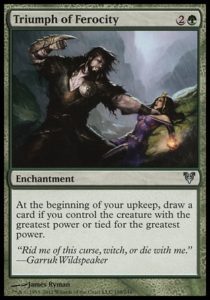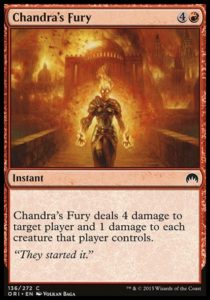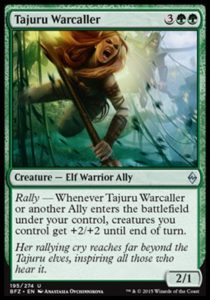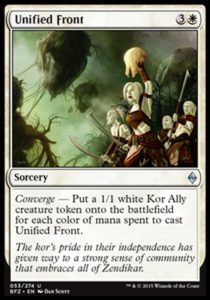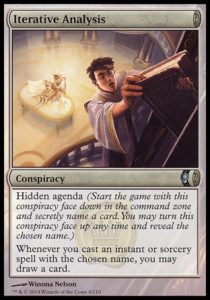Look up and you’ll see the gruesome artwork for [casthaven]Grip of Desolation[/casthaven] up close. An angel is being brutally crushed to death, a horrible death-by-Eldrazi. Unsurprisingly, there’s a lot of death in Battle for Zendikar; the set features an all-out war for the survival of both the Zendikari and Zendikar itself. What’s unusual here is that in all of Battle for Zendikar, this is the only card which clearly features a woman being harmed.
I’m writing a statistical analysis of Battle for Zendikar for my Game Studies class and I was surprised by the gender representation in the set. Of all cards where a humanoid (non-Eldrazi) character is the focal point of a card’s artwork, 41% feature a woman. That’s pretty good representation, considering that 38% of all Magic players are women. However, I noticed some bizarre tidbits, like with [casthaven]Grip of Desolation[/casthaven]. Let’s take a look at a bit of the data.
Consider every card in Battle for Zendikar in which a humanoid (non-Eldrazi) creature is injured or dies:
- [casthaven]Gruesome Slaughter[/casthaven]
- [casthaven]Scour from Existence[/casthaven]*
- [casthaven]Titan’s Presence[/casthaven]*
- [casthaven]Sheer Drop[/casthaven]
- [casthaven]Adverse Conditions[/casthaven]
- [casthaven]Horribly Awry[/casthaven]
- [casthaven]Oracle of Dust[/casthaven]
- [casthaven]Transgress the Mind[/casthaven]
- [casthaven]Complete Disregard[/casthaven]
- [casthaven]Demon’s Grasp[/casthaven] (also counts as a creature killing another creature, which we’ll consider in a moment)
- [casthaven]Grip of Desolation[/casthaven] (an angel is dying; this is the only definite instance of a woman dying)
- [casthaven]Vampiric Rites[/casthaven]
- [casthaven]Ruinous Path[/casthaven]
- [casthaven]Processor Assault[/casthaven]
- [casthaven]Serpentine Spike[/casthaven]
- [casthaven]Touch of the Void[/casthaven]
- [casthaven]Brutal Expulsion[/casthaven]
*It has been brought to my attention that the vampire being annihilated on [casthaven]Scour from Existence[/casthaven] is likely a woman. The gender of the character being annihilated on [casthaven]Titan’s Presence[/casthaven] is also unclear. Neither of these invalidates this information, but suggests the set may be more egalitarian than it initially appeared.
Across 17 cards, only 1 (or 2) depicts a woman being harmed, and the only one(s) harmed are nonhuman. While women are rather prevalent in BfZ, they’re mostly absent from cards where violence is done to them.
Let’s now consider cards where humanoid characters are the agents of violence. Here’s the gender representation among humanoid creatures fighting or killing another creature:
- [casthaven]Smite the Monstrous[/casthaven]
- [casthaven]Altar’s Reap[/casthaven]
- [casthaven]Outnumber[/casthaven]
- [casthaven]Reckless Cohort[/casthaven]
- [casthaven]Sure Strike[/casthaven]
- [casthaven]Turn Against[/casthaven]
- [casthaven]Plummet[/casthaven]
- [casthaven]Munda, Ambush Leader[/casthaven]
- [casthaven]Demon’s Grasp[/casthaven]
[casthaven]Outnumber[/casthaven] features multiple men felling an Eldrazi with one woman in the background attacking from behind. [casthaven]Smite the Monstrous[/casthaven] is an egalitarian band of Kor taking down an Eldrazi with ropes (with no clear focal Kor character). [casthaven]Plummet[/casthaven] features an elf of indeterminate gender about to take down an Eldrazi. The remaining six cards feature an obviously male character fighting or killing another creature (technically [casthaven]Reckless Cohort[/casthaven] features one man with a second in the background). On no card does a woman directly combat another creature.
Finally, let’s consider the cards where a woman is seemingly in combat or using magic on an enemy:
- [casthaven]Angelic Captain[/casthaven] (charging towards an unseen foe)
- [casthaven]Chasm Guide[/casthaven] (charging towards an unseen foe)
- [casthaven]Tajuru Warcaller[/casthaven] (charging towards an unseen foe)
- [casthaven]Exert Influence[/casthaven] (using nonlethal blue magic)
- [casthaven]Roilmage’s Trick[/casthaven] (using nonlethal blue magic)
- [casthaven]Tightening Coils[/casthaven] (using nonlethal blue magic)
These are the only cards in which a female character is engaging an enemy. If she’s holding a weapon, then the enemy she faces is unseen. If she’s wielding magic, her magic is nonlethal.
What does this mean? It’s certainly strange that when women are featured on 41% of all cards that they’re almost entirely excluded from explicit combat. In the few instances where a woman is depicted as fighting or dying, she’s either not human (distancing the viewer from her to a degree) or attacking from the rear while men attack the enemy head on. In the majority of instances where a woman is fighting, she’s either facing an invisible foe or using nonlethal magic.
So, what does this all mean? Why are women underrepresented in such a specific context? Part of this could be due to the legacy of [casthaven]Triumph of Ferocity[/casthaven]; Wizards may discourage artists from featuring women in peril for fear of repeating what’s likely their biggest art mistake in the last several years. It could also be due to the nature of the Eldrazi; consider the victim in [casthaven]Complete Disregard[/casthaven], the one whose lower body is covered in tentacles, and imagine that they were female. Wizards has good reason not to evoke tentacle porn. Perhaps this is completely unintentional, a consequence of artists being more squeamish with depicting women dying. Perhaps it’s a statistical aberration and the past several years have been egalitarian to both women and women in combat.
That said, none of these suggestions address why women aren’t shown as engaging or winning in combat. Excluding women from combat is making a value judgment, saying that women can’t be agents of action. And that’s neither a good nor fair nor accurate statement.
With more time, I’d be very interested in expanding this study to include the last five years of Magic. But that’s a consideration for another day. My goal was to share this data I’ve found with only a dab of analysis.
So… what do you think of it? Should Magic feature more women in combat? Is this a problem? Is this a good business decision? My money’s on equal representation being the preferable option, but I’d like to hear what you think. Please, share your thoughts in the comments below.
And, as always, thanks for reading.
—Zachary Barash
Zachary Barash has been playing Magic on and off since 1994. He loves Limited and drafts every available format (including several that aren’t entirely meant to be drafted). He’s a proud Cube owner, improviser, and game designer. He has an obsession with Indian food that borders on being unhealthy.

